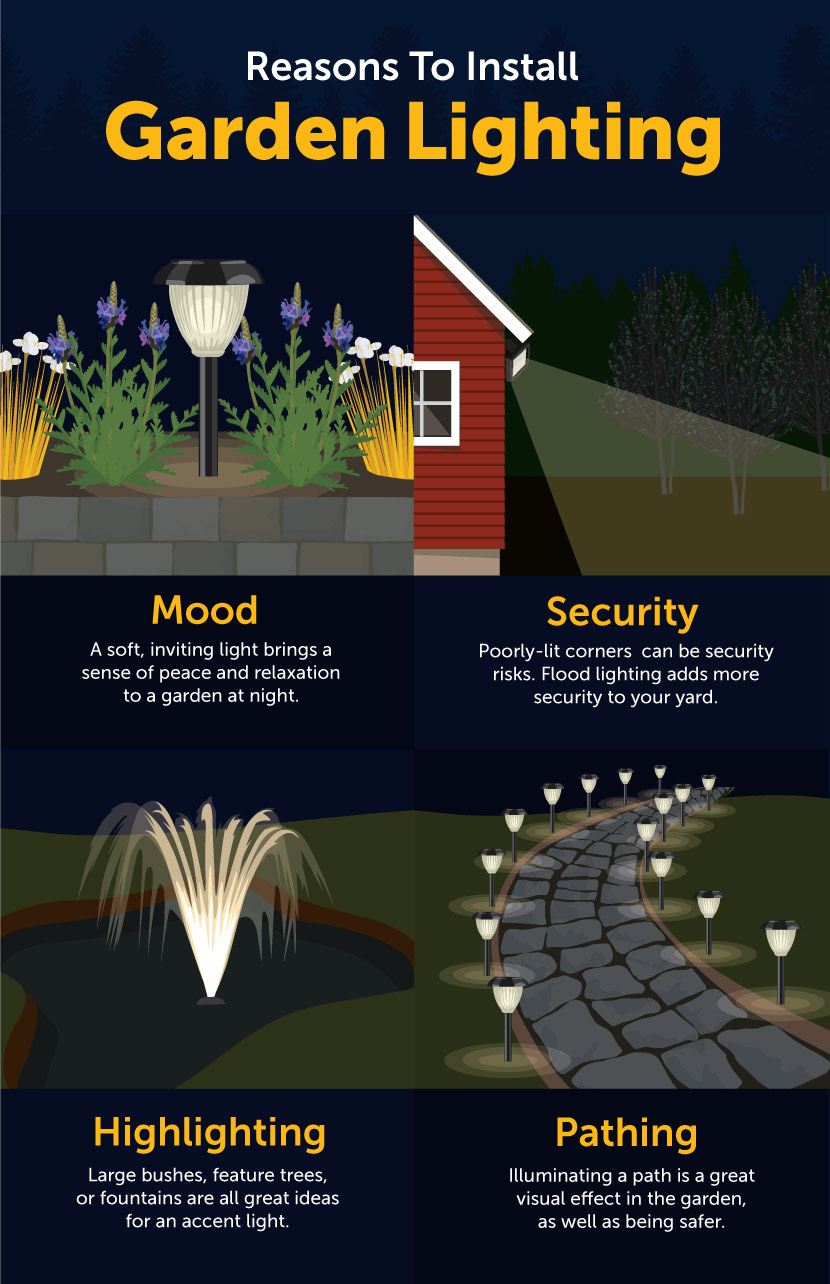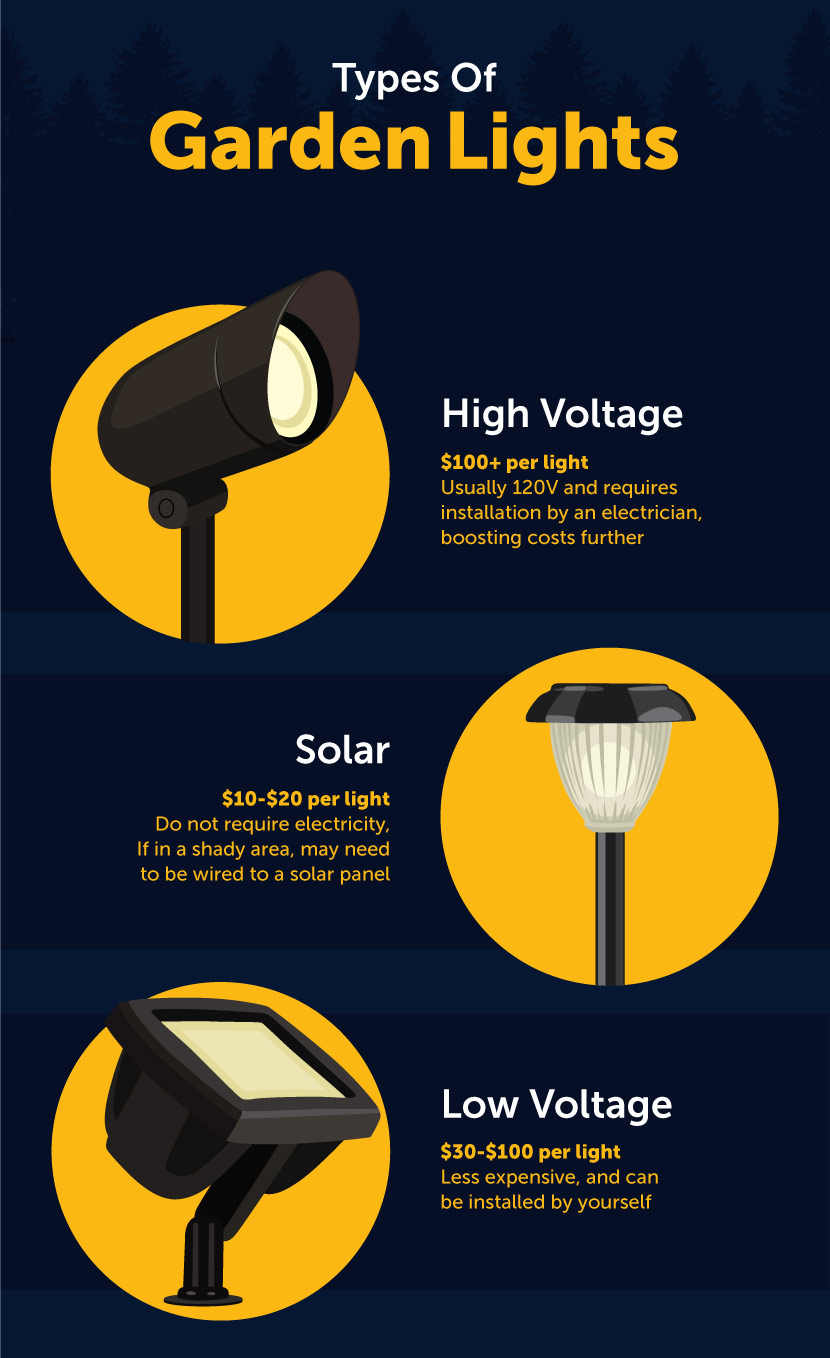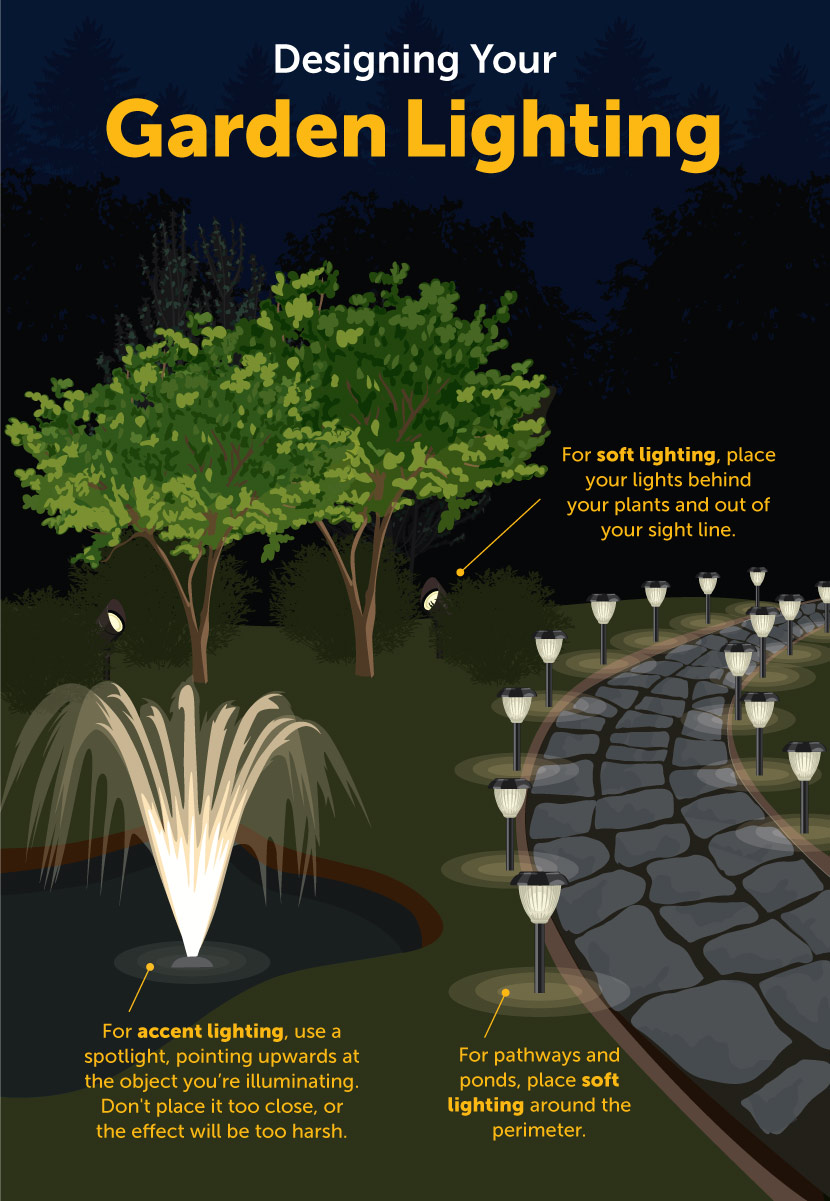Illuminate Your Garden With These Garden Lighting Ideas
If you’ve spent a lot of time gardening,
there’s nothing better than simply enjoying the garden and landscaping that you’ve dedicated so much time to.
For a pastime that often requires a lot of hard work, sometimes it’s nice to just relax and bask in the beauty you’ve created.
There are many ways to do this,
but one often-forgotten method is installing lighting in your garden so you can enjoy it at all hours.
 Before you hit the store to purchase lighting,
it helps to give some thought to the main reason you want garden lighting in the first place.
Many people simply want a nice-looking landscape, but there are practical reasons as well.
Before you hit the store to purchase lighting,
it helps to give some thought to the main reason you want garden lighting in the first place.
Many people simply want a nice-looking landscape, but there are practical reasons as well.
Creating a Mood
A soft, inviting light brings a sense of peace and relaxation to a garden at night. It can transform a dark and uninviting backyard into a wonderland of color and feeling.Adding Another Layer of Security
In many yards there’s an area that is poorly lit and prone to security risks. Installing motion-sensor flood lighting is one option to mitigate this risk, but you can also install a softer light that serves an aesthetic purpose by illuminating that poorly-lit corner.Safer Garden Paths
Illuminating a path with lighting looks great and also functions as an extra safety measure. Whether you’re walking through your garden at night or hosting a late-night get-together, a well-lit path is always a good thing.Showing off an Accent Piece
If you prefer a more spartan approach to your garden lighting, you can go with spotlights on larger bushes, fountains, or other accent pieces in the garden.
High Voltage or Line Voltage Lighting
High voltage lighting is by far the most expensive type of garden lighting out there, and for good reason. It’s also the most powerful, drawing 120 volts and requiring a professional electrician for installation. A quality high voltage light will run upwards of $100 per light, not including the cost of installation. They are a good choice if you can afford to buy enough high voltage lighting to illuminate your entire garden and want a robust lighting setup in your yard.Some Prominent High Voltage Lighting Brands Include:
Low Voltage Lighting
Low voltage lighting is the middle-ground choice. It’s less expensive than high voltage lighting, coming in at around $30-$100 per light. It also doesn’t require the expertise of a professional electrician to install – an experienced do-it-yourself gardener can install low voltage lights, though some people still opt for an electrician’s help.Some Prominent Low Voltage Lighting Brands Include:
Solar Lighting
Solar garden lights are by far the most popular type of lighting, for a few good reasons. First, they’re inexpensive, running around $10-$20 per light. This means you can get a lot of them and play around with their configuration in your garden, making them a flexible choice. Second, they don’t draw any electricity due to the photovoltaic panel that’s built into them. This means the only cost you’ll ever incur is the initial purchase cost – the energy to run them comes to you for free via the sun. If you decide to go with solar garden lights, consider carefully where you will place them. Because they draw their power from the sun, they need to be in a well-lit area during the daytime if they’re going to have enough energy to run well at night. If you can’t avoid placing them in a dimly-lit area of your garden, you can install a separate solar panel and run a wire to the affected solar lights. However, at that point, you may want to consider a low voltage light for dimly-lit areas to avoid the hassle.Some Prominent Solar Lighting Brands Include:
LED Lighting
LED lighting is growing in popularity across the board, so it’s no surprise it’s showing up in garden lighting as well. The 6-7x efficiency increase that LED lights offer makes them an attractive choice for homeowners that need to light their garden, but don’t need high-voltage, expensive lights.
If you decide on LED garden lights, the most important decision you make is the color of the lights. Because LEDs are made up of many light-emitting diodes, it’s possible to have multicolored lights.
It’s recommended to stick with 2700K white LEDs if you want a warm, classic light to bathe your garden. Save the colored LED garden lights for a party atmosphere or a single accent.
Some Prominent LED Lighting Brands Include:
 It can be overwhelming to look out at your landscape and try to figure out where to place all of your garden lights.
Fortunately, you don’t need to be a design expert to create a wonderful garden lighting plan. All you need to do is a little pre-planning and critical thinking.
It can be overwhelming to look out at your landscape and try to figure out where to place all of your garden lights.
Fortunately, you don’t need to be a design expert to create a wonderful garden lighting plan. All you need to do is a little pre-planning and critical thinking.
Make a Map of Your Garden
The first step is to sketch out your landscape in as much detail as possible. The idea here is to get an understanding of where existing lighting, plants, and other features are. Once you know where all of these features are located, you can start to plan around them and visualize how your new garden lights will add to or detract from the design that you want to create.Place Your Lighting
With the sketch of your garden complete, you can start to lay out where your new lights will go. It’s important to make note of the type of lights you’re using and how they will play off of the existing features in your garden. Here are a few general rules to follow when placing your lights:For Soft Light
Place lights out of your sight line. Under or behind bushes or shrubs is a good location – the plants will diffuse the light, making it less harsh on the eye.For Accents or Highlights
Be careful not to use a single spotlight that points directly at the feature you want to highlight. This creates an extremely harsh contrast, and while it technically does highlight the feature, it’s too strong. A better approach is to use two or three lights, all pointing at the feature from different angles and distances. This creates a more diffuse effect while still calling attention to the piece you want to feature in your garden.For Garden Paths and Ponds
Garden paths and ponds are a great use case for solar lighting. The most common method is placing solar lights every four to five feet on both sides of a garden path or around the entire perimeter of a garden pond. This is an inexpensive way to create an attractive (and safe) accent in the garden. No matter what your budget is or the size of your yard, it’s possible to create a beautiful and functional landscape lighting layout. Consider the primary reason you want to light your garden and your maximum budget to get the job done, and then set about planning everything before you commit to any purchases. With a little effort and creativity, you can turn your drab, dark yard into an illuminated masterpiece.Embed the article on your site

























































